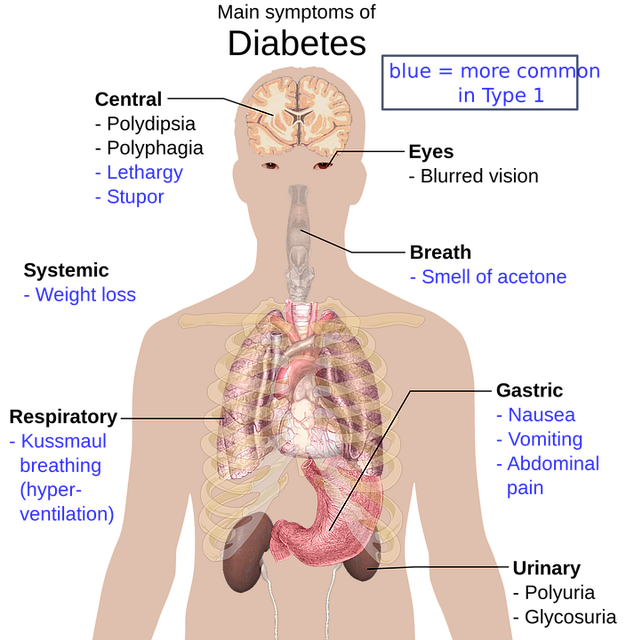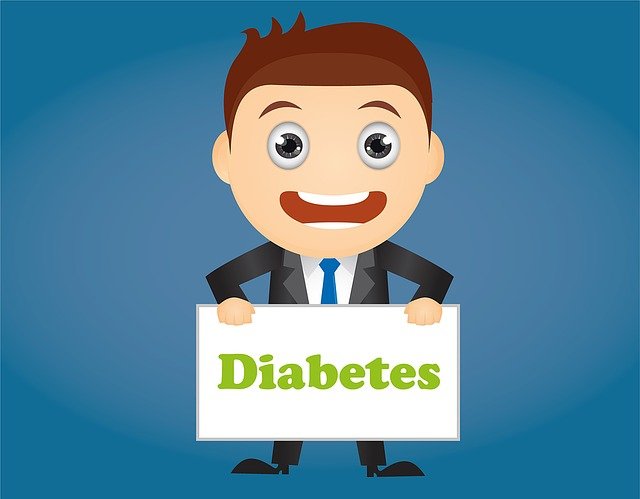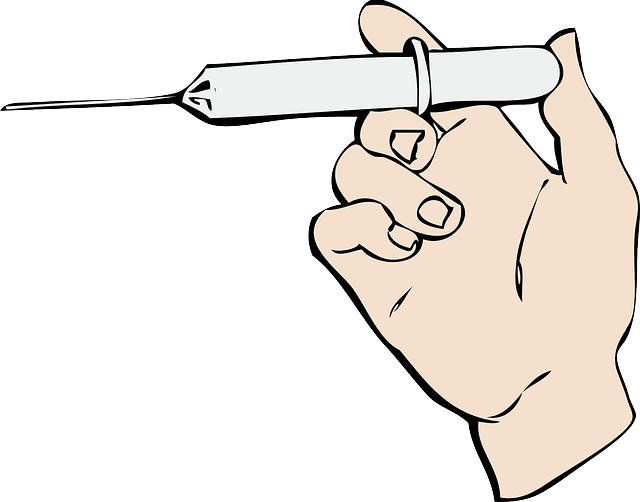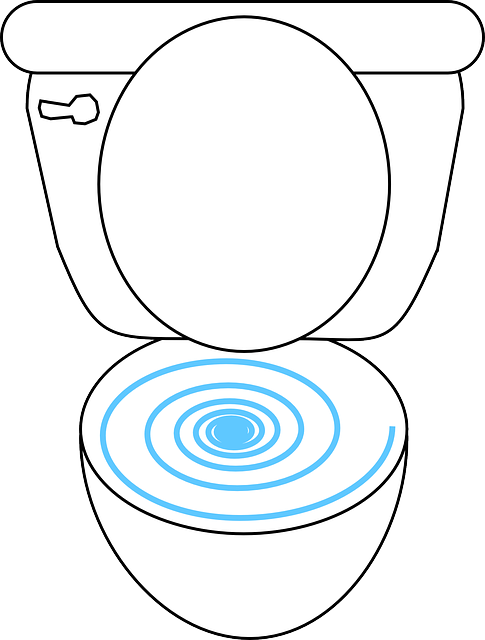Breaking Down the Basics of Diabetes: A simple way to understand the pathophysiology of diabetes (Part I).

It is my pleasure as a senior medical student and Type I diabetic to help the “common man” understand the disease processes of Type I and Type II diabetes.
Let’s face it—diabetes is a hard topic to truly grasp. Everyone has heard about it and perhaps are personally affected by it!
It is my goal with this post to help those who want to understand diabetes, a rapidly growing epidemic in the United States. For those who already have the disease, I hope this is an informative guide to understanding your condition…maybe even to take control of this manageable problem!

There are two main types of diabetes: Type I (T1DM) and Type II (T2DM). Since diabetes is an extensive topic, this post will be dedicated to Type I diabetes. It usually occurs in childhood and affects about 1 in ever 400-600 children/adolescents. Over 1 million Americans are affected by this disease (Ref 1). Type II diabetes is very common, but a rather different disease process.
Type II diabetes will be covered in another post in similar format.
Before going into the gory details of T1DM, I want to make it easier to understand by telling a simple story of a boy named Ty.
The Story of a 14 Year-Old Teen named Ty.

Ty was just a normal teen boy, finishing up his last years of junior high. He had everything he needed: friends, good grades, a good sense of humor, and a want and desire to be a future medical doctor.
All the sudden he started to feel “weird.” He could concentrate but had an increase desire to drink water—and lots of it! He decided to bring a water bottle to class to relieve his unquenchable thirst.
He would drink it every hour during class and would fill it up again before entering the next class. With the excess consumption of water, he noticed he had to urinate frequently. After about a week of these annoying symptoms, it got worse. Not only was he thirsty, but he started to feel weak. Not weak like he needed to sleep, but weak like his muscles were not working. He tried to make a fist with his hand and realized that it was hard to even close his hands! He weighed himself and realized he had lost 7 pounds in less than a week. He was a short kid and only weighted about 72 pounds. Wow! What was going on?
But Ty was not like most kids his age... His mother and father were both medical doctors, and he had heard about the symptoms of diabetes. Hell, even one of his classmates knew a person close to her with diabetes and felt that Ty’s concerns were real.
He went to his mom and dad and asked them to check his urine for sugar. They didn’t believe him; how could their “sweet boy” have such a condition? His mother even thought cancer was a stronger possibility.
His dad came back from the drug store with the urine dip-stick kit. The strip turned dark brown, indicating without-a-doubt... diabetes. In addition, he had trace amounts of ketones in his urine. He went to the emergency room where they checked his blood sugar, which read... 446mg/dl! There he was, a teen with his whole life ahead of him, with the diagnoses of Type I diabetes (T1DM).
This Ty guy was ME. This is my short-version of my true experience with diagnosing myself with Type I DM.
The point of this post is not about an epiphany/sob-story…its about informing you about T1DM. My personal story here tells of the symptoms of T1DM at diagnoses. This will help as we venture into the pathophysiology of T1DM. So let's get started!

Why Does One Get Type I Diabetes?
Type I Diabetes (T1DM) is an autoimmune disease. Autoimmune means that the body’s immune system actually fights against itself!
Why in the heck would it do that?
Actually…that is a great question that we only have theories on at the moment. One of the biggest theories out there is that a common virus, that may cause something as simple as the “common cold,” causes molecular mimicry (I know, big word!).
This virus is composed of proteins called antigens. When your immune cells identify that antigen, it tells your body to attack.
What does your body use to attack?
Immune cells identify that antigen and help bring in toxic cytokines that destroy that virus protein. T-cells link up with B-cells and also release killing factors, factors that bring in more immune cells, and there are T-cells that by themselves can kill these viruses.
However the word molecular mimicry means that the the virus has adapted due to evolution and has proteins that look a lot like our own human antigens.
In a normal person, once the virus is killed, the immune system goes back to “normal.” However, through genetic predispositions (scientists are still working out the actual mutations in Type I, but have identified HLA variations that predispose one to get it) and molecular mimicry from a virus, the immune system "thinks" the same antigen from the virus is present in the beta-islet cells of the pancreas! So the immune system is in overdrive until all the beta-islet cells of the pancreas are killed.
WOW!
These beta-islet cells in the pancreas are what produce insulin. However, the immune system does not kill all of the other cells in the pancreas, which are vital for food metabolism.
BOTTOM LINE:
Type I diabetes is an autoimmune disease, which means that one's own immune system kills the beta-islet cells of the pancreas. It is believed that a viral trigger and genetic predispositions initiate the immune system to attack the pancreas. Once the immune system kills off the beta-cells, there are no insulin producing cells left in the T1D. However, the pancreas is still working by producing digestive enzymes necessary for proper food digestion.
Genetics does increase the chance of T1DM and it is believed that multiple genes are involved, some of which we are still not aware of. If one identical twin has T1DM, there is a 50% chance that the other will have it sometime by the age of 40 (Ref 1). However, they typically don’t get it at the same age, which supports the hypothesis of the viral trigger being a component of the disease etiology. If I have children in the future, I will have a 4-6% chance of passing diabetes to them (Ref 1). Not a very high chance, but one that is worth noting!
So What Does Insulin Do?

Insulin is a compound that allows the glucose (sugar) in your blood to get out of the bloodstream and into the cells that use that sugar for fuel. Since Type I diabetics have no insulin, due to their own body killing off all the insulin producing cells (as discussed above), the body has no way to get the sugar out of the blood! To make things more complicated (sorry about this), not all cells require insulin...
The brain and liver have GLUT transporters that do not require insulin (insulin independent). This is for good reasons. If the brain needed insulin to think, then a T1DM would be dead before they knew it. The brain can use multiple sources of energy, but sugar is the primary and necessary one. The liver stores and produces sugar; another main reason why it is convenient that it is insulin independent.
The cells that are insulin dependent (require insulin) include the adipose tissue (fat cells) and muscle. Muscle cells have GLUT-4 transporters on their cell membranes, which require insulin to drive the sugar from the blood into the muscle tissue; it uses this as energy.
Therefore, without insulin, the GLUT-4 transporter is like a locked door not allowing the sugar to escape the blood; the closed door is also not allowing the muscle cells to receive sugar as fuel. The process is actually much more complicated than described here. Insulin actually causes a cascade of events to occur in order for the GLUT-4 transporter to open... but that could be a whole post on molecular biology by itself!
Bottom Line:
A simpler way to express all this information: Insulin is the key to open a door (the insulin dependent GLUT transporter) on fat and muscle cells so that the sugar in the blood can leave the bloodstream and get into the fat and muscle cells. Without the “key" insulin, the door to these cells is “locked,” and the sugar is essentially “trapped” in the blood.
Why Do Diabetics Experience the “Classic” Symptoms?
Great question!
I will break these symptoms down into the common symptoms... as seen in my personal diagnosis history above and explain the reasons for each one.

1) Polydipsia (Increased thirst) and Polyuria (increased urination):
Most people know that diabetics are very thirsty if undiagnosed/poor blood sugar control…but why?
To explain this, I have to take you back to high school biology and to the topic of osmosis. Osmosis is essentially that water will always flow to the area of higher solute concentration. For example, if you were to take a big swimming pool and put a big filter in the middle of it, the water would still be equal on both sides. However, if you placed more big rocks on the left and less rocks on the right side of the pool (the solute), the water would flow through the filter where there are more rocks.
In diabetes, the solute is glucose (sugar). So since there is no inulin production in a T1D, the sugar in the blood stream increases. This brings the interstitial fluid and intracellular fluid out of the cells and into the blood stream.
The blood is then filled with more water and is taken through the kidney and "peed out". The kidney actually tries to reabsorb all the sugar in the blood stream to put back into the body because it is an important energy resource. When the blood sugar reaches 170-180mg/dl, the kidney is unable to reabsorb the sugar and is "spilled out” into the urine.
Bottom Line
Easy Summary: Sugar trapped in the blood causes an osmosis effect that drives the water in the body into the bloodstream, which is then "peed out". This causes more urination. When you urinate more you also have less water in the body, which makes you very thirsty.
2) Polyphagia (increased hunger) Rapid Weight Loss, and Muscle Fatigue:

This occurs because your adipose (fat cells) and muscle cells are not recieving sugar as a fuel source. With no insulin, the body is unable to transport the sugar from the blood into fat and muscle cells. This causes “starvation.” The muscle and fat cells are essentially starving in a closed bath surrounded by excess glucose. The body then breaks down the fat and muscle to try and make more fuel for the body to use.
This is naturally why a T1DM can lose weight rapidly. Before insulin was invented, T1DM was a death sentence. One would likely die from diabetic ketoacidosis (DKA), where the blood becomes acidic from ketone production (to explain this would be a completely different post and takes a little biochemistry to explain). The other causes of death from untreated Type I diabetes would likely be from dehydration and “wasting away.”
I hope this post was informative for all, and I look forward to explaining Type II diabetes in the near future!
Some of the number statistics I got from the the Medscape article on Type I diabetes, which can be found below:
Ref 1) http://emedicine.medscape.com/article/117739-overview#a4
*All pictures are from pixabay.com and no sources are needed
*The majority of this article is truly just the facts I know as a senior medical student, personally having diabetes, and the countless research I have done since I was 14 years old.
If there are any mistakes or confusion on some of the facts presented, I would be happy to entertain any questions.
*Some of the information has been “simplified” for the reader. For instance, in my storytelling fashion, I often act like the kidney or other body parts are "thinking" to "prevent" something. This is an over-simplification and meant to help understand the various processes. More microbiology and biochemistry would have to be explained to understand this phenomenon (I did not want to bore you guys to death haha).
Thanks for your time and attention to this important topic!
This is a current picture of me. Feel free to follow for more on diabetes, religion, and random hobbies of mine!

I also have type 1 (a little over five years now...) and it can get really frustrating when the general population has no idea that type 1 is different than type 2. It's scary when people tell me, "Oh well if your blood sugar gets low that means you need insulin! Do you want me to practice giving you insulin, just in case of emergency?" which I've heard from friends and family on more than one occasion... It's scary and I hope I'm never in a situation where I'm unconscious and a well meaning loved one does the wrong thing.
And it's not like I've explained and corrected them, there seems to be a much stronger culturally enforced idea of diabetes ingrained upon them that seems impossible to overcome. I've gotten more and more discouraged from educating those around me about my condition, but it's good to see others like you who are getting the truth out there. Keep it up!
You make an excellent point that was not addressed in this post; the lack of awareness. It is important for people to be educated, or they really could kill someone! I was strictly keeping the topic to the pathology/physiology of the disease of Type I, which generally will not cause hypoglycemia (however when the autoimmune process is going on, it actually can cause the beta-cells to release more insulin as the beta-cells are dying. I did have symptoms of mild hypoglycemia before I stopped making insulin. I am curious to know, did this happened to you?...) A whole topic could/should be given to the management of diabetes, and the resulting side effects of hypoglycemia (low blood sugar). I will address that in this comment below, briefly, for others to view. Thank you for sharing your personal experience, and I look forward to reading your future posts. There is much overlap with symptoms and side effects of treatment with Type I and Type II diabetics, which may be an opportunity to include more on hypoglycemia in future posts.
Hypoglycemia (low blood sugar) occurs when you give too much exogenous insulin. In other words, you inject too much. This can happen for many reasons.
A Type I diabetic can get it from taking too much rapid acting/regular insulin with not enough carbohydrates at meals (carbohydrates break down into "simple sugars" within 30 minutes). A Type II can also get if they also take insulin (which some do not require). When someone is "low" (low blood sugar), giving them candy or a sugar drink is already in "simple sugar" form and will take about 10 minutes to raise their blood sugar.
Long acting/intermediate insulin (insulin released over time, which I can explain in a management post) can cause hypoglycemia if the wrong dose is administered or if a specific type is taken (NPH) and a meal is not eaten around 6 hours after the dose is given....NPH insulin "peaks" at around 6 hours.
Type II diabetics can get hypoglycemia from taking certain medications. Some of note, and most dangerous, are the sulfonylurea class drugs like Glimeperide. Drugs like Metformin, actually, do not cause hypoglycemia, which can be explained later.
Like @theb0red1 noted a lack of awareness from the caregiver or "good samaritan" could lead to death. If one does not understand the disease process, they could actually give insulin when the diabetic is already suffering from low blood sugar. If unsure, do not give the patient insulin and call for emergency assistance. Try and check the blood sugar as well. I will go into symptoms of hypoglycemia in a future post.
Exercise is a big one to cause hypoglycemia (will give more on this in a future post. The physiology of this is actually fascinating, and I just fully-understood this about a month ago).
*I am probably forgetting some more and can elaborate in a later post. Main point of this comment/second post is if you see a diabetic unconscious or acting "funny" always think low blood sugar rather than high sugar and think "this patient needs sugar" over "this patient needs insulin" (which could kill them).
I am damn proud of you for writing this post! You have turned a personal tragedy into making life less tragic for so many other people.
Thanks for the kindness and support, @ragingliberty. I look forward to writing Part 2!